
Inca Trail Trek to Machu Picchu: Ancient Path to a World Wonder!
Inca Trail AvailabilityHike to Machu Picchu by The Inca Trail Trek - Peru trek!
Local Expertise and a Top-Quality Service on The Inca Trail Since 2009!
The Inca Trail Trek to Machu Picchu -Summary.
This guide explains how to be a responsible traveler on the Inca Trail and across Peru by respecting culture, supporting local economies, reducing waste, conserving resources, and following Leave No Trace principles.
It emphasizes choosing sustainable, ethical operators and fair treatment of porters, detailing Peru’s new Porter’s Law and its implications. Valencia Travel Cusco outlines its sustainability initiatives and calls on trekkers to pay fair prices, follow regulations, and help preserve Machu Picchu’s fragile ecosystems for future generations.
Why Hike the Inca Trail to Machu Picchu?
Discover the mystique of Peru's heartland. Hike the Inca Trail Peru with Valencia Travel Cusco. Our exclusive Inca Trail hike to Machu Picchu immerses you in awe-inspiring Peruvian countryside. The trail will guide you through the Andes along the ancient pathways of the Incas to reach the iconic Machu Picchu.
The world-famous Inca Trail hike is the ultimate trekking route in South America. It follows one of the many ancient roads created by the Incas centuries ago. Passing iconic archaeological sites such as Wiñay Wayna along the way, this iconic trek is the only route that allows you to enter Machu Picchu through the Sun Gate.
The altitude is going to push you to your limits. The ascents and descents will test your mental focus. The ever-changing scenery will stir your soul. But it's in the quiet moments. When you're catching your breath, sharing stories with fellow trekkers under a starry sky, or enjoying a warm meal lovingly prepared by our chef, that the true magic unfolds.
Inca Trail Tours and Itineraries
Our different Inca Trail packages include the 2-Day Short Inca Trail. The 4-Day Classic Inca Trail. The 4-Day Classic Inca Trail - Premium. The 5-Day Classic Inca Trail Trek. The 5-Day Inca Trail Express and the 7-Day Hike The Inca Trail to Machu Picchu.
All these hikes follow original Inca pathways, carved out of the mountains centuries ago. These treks offer the perfect mix of camping and trekking to get to Machu Picchu. There is even an Inca Trail option for those who prefer not to camp on their Inca Trail adventure!
So, no need to bring a sleeping bag! Whichever trek you decide on, you are guaranteed an unparalleled adventure through history and astounding Peruvian nature.
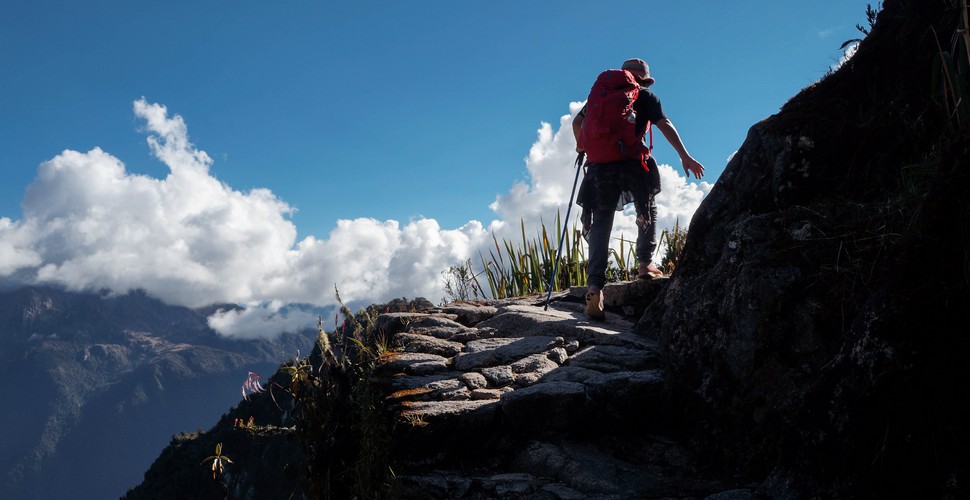
What You Need To Know About Hiking The Inca Trail:
- The hike covers approximately 42 kilometers (26 miles).
- The difficulty of the Inca Trail ranges from moderate to challenging. This is due to the altitude and varied terrain.
- The highest point on the trek is Dead Woman's Pass at approximately 4,215 meters (13,828 feet) above sea level.
- Permits for the Inca Trail are compulsory. They must be secured in advance due to limited availability. Permits often sell out a year in advance, especially for high-season dates! We highly recommend reserving in advance! (see more here)
- All hikes are led by authorized local guides. Only official Inca Trail Tour Operators can take you on this trek and secure your permits. This is to ensure safety and compliance with safety regulations. Implemented by The Ministry of Culture.
- Pack animals are not allowed on the trail. Your equipment and personal items will be carried by porters. They come from the local community!
- You need to bring with you the passport you used to book your trek, or you will not be allowed to hike! If you change your passport before your trek, let us know! We can make the necessary changes for you on your permit.
- Permits for the trek are non-refundable and non-transferable. You will not be allowed to change your dates for ANY reason. The only way around this is to purchase a completely new permit! Of course, this will depend on availability.
- You´re guaranteed an adventure! This is the trek of a lifetime through the Andes of Peru. A bucket list item for many people. You will certainly earn bragging rights for completing the awe-inspiring Inca Trail!
Valencia Travel Cusco is committed to sustainable tourism. We offer an unparalleled trekking service. So that your hike is beyond extraordinary.
More Information? Check out our All You Need to Know About Hiking the Inca Trail!
Inca Trail Permits
The Peruvian government introduced the Inca Trail Permit System with the aim of mitigating severe overcrowding, excessive wear, and erosion along the revered Inca hike. Each day, a restricted quota of permits is allocated to regulate access to this historic pathway.
Important Information for the Inca Trail
Inca Trail Permits and Availability - Is There Space for Your Dates?
+All About Inca Trail Permits
The Inca Trail to Machu Picchu
Trip Planning When You Hike to Machu Picchu
Any Inca Trail hike requires an Inca Trail reservation. You cannot hike the trail without an official permit. An Inca Trail permit can only be booked with authorized tour operators in Peru. There is a set number of permits issued for the Inca Trail for each day of the year. The trail is open all year round except for the month of February.
Check our Inca Trail Availability Calendar below. To see if permits are available for the dates you would like to hike to Machu Picchu. Popular trekking dates can sell out months in advance! For Example, May to August.
To learn more about permits, check out our informative blog. What are your options if you are late to the game for an Inca Trail permit? Don´t worry, we have got you covered! Read more in our article - No Inca Trail Permits - No Problem!
Inca Trail Availability Calendar

Why Do You NEED a Permit?
The Inca Trail Permit System was introduced by the Peruvian government. This is to help preserve the original Inca pathway. The idea is to avoid overcrowding, as well as overuse. To avoid a negative impact along the historic route.
A restricted number of permits are issued each day. This limits the amount of foot traffic on the pathways at any given time. Permits are required for all trekkers, including hikers, porters, and guides. The Classic Inca Trail is hiked by many people today.
It is a section of the original Inca Trail, which formed part of the Qapaq Ñan (The Inca Road Network). This was built in the 15th century by the Incas to arrive at the remote Machu Picchu specifically. The Inca Trail Peru enters Machu Picchu through the iconic Sun Gate.
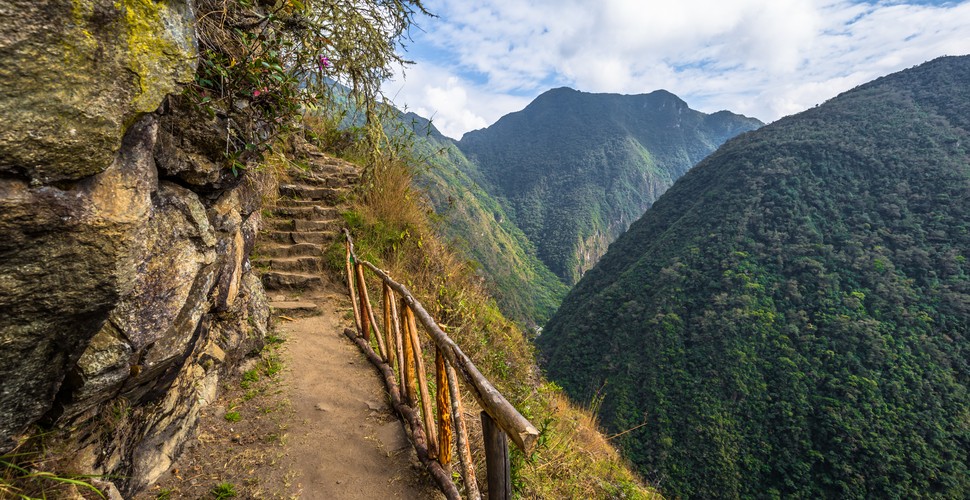
Permit Restrictions Along The Trail
There is a strictly controlled number of daily hiking permits. These are issued by the government. They are the reason why you need to book your Inca Trail Peru in advance. There are only 500 permits issued each day, which is why they sell out fast! Inca Trail permits can sell out up to a year in advance for popular trekking dates.
These dates generally fall between May and August. This coincides with the summer holidays in Europe and the USA. Valencia Travel has a high success rate in helping travelers secure their preferred permit dates. As long as trekkers book their trek in advance.
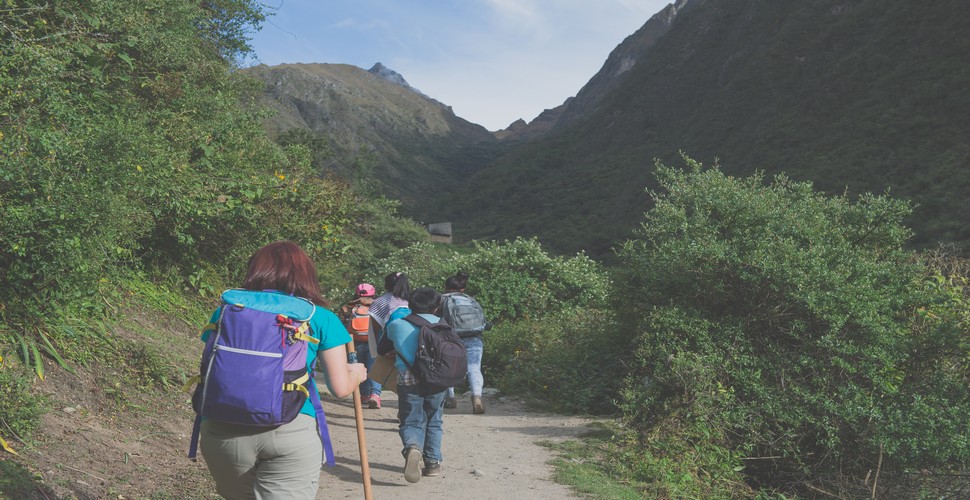
Why Was The Inca Trail Permit System Introduced?
Machu Picchu was declared a UNESCO World Heritage Site in 1983. Since then, the popularity of Machu Picchu has increased exponentially.
The number of people who want to hike the Inca Trail has dramatically risen. Erosion, overhiking the pathways, and the rubbish left behind at campsites. These threatened the pristine Andes as well as the ancient archaeological sites.
Geologists, studying the area’s land movement, announced that it was in danger of collapse. So, in 2000, the government of Peru chose to limit the number of daily visitors on the hike to 500 people. This included everyone – trekkers and tourists, but also porters and guides. The fear of losing this ancient road.
As well as the need to protect people. From Peru and around the world. Led the government to enact the first-ever limit for trekking the Inca Trail. Learn more about hikes to Machu Picchu in this Guide to Hiking to Machu Picchu.
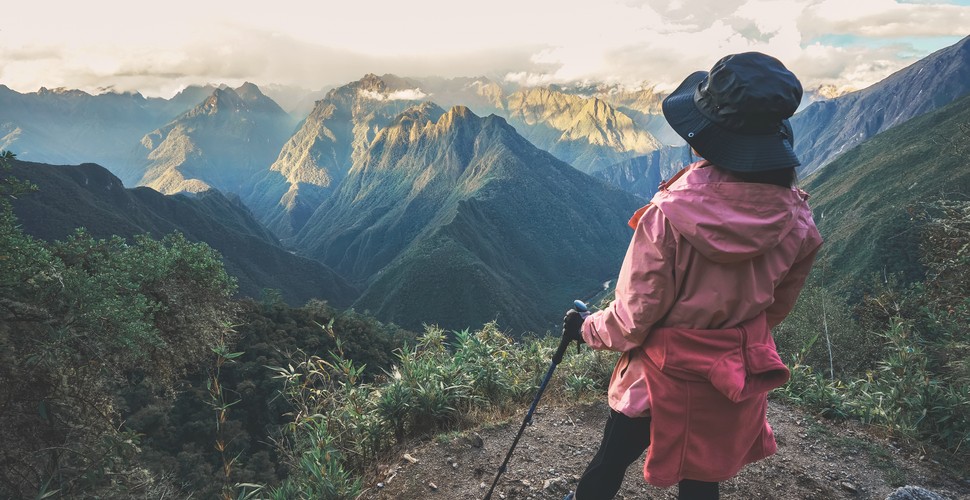
How Many Inca Trail Permits Are Available Each Year?
- Only 500 total permits are available each day.
- Of these 500 permits, 300 are allowed for support staff. Such as guides, porters, and cooks, and the other 200 permits are reserved for all paying hikers.
- You can only hike with a licensed tour operator (such as Valencia Travel).
- Entrance points and campsites are pre-determined on your Inca Trail permit. This is enforced at each control checkpoint.
- Permits are non-refundable and non-transferable. Dates and names cannot be changed.
- All permit regulations are monitored by the Peruvian government. Not by trekking agencies.
- *Note that the Inca Trail is closed every February for maintenance. This is because February is the wettest month of the rainy season in Peru. This also helps reduce the amount of damage caused to the road by trekking in wet conditions. It is also one of the less-visited months of the year by tourists and trekkers to Peru.

How Do Inca Trail Permits Work?
Inca Trail permits are required for all hikers who wish to hike this ancient Inca road. There are two main options: The classic 4-day Inca Trail Hike or the shorter 2-day Inca Trail.
These permits are issued to regulate the number of visitors on the trek. It also protects the fragile ecosystem. Thus preserving the historical sites along the route. Here's what you need to know about these permits:
Types of Permits: Which Treks to Machu Picchu require an Inca Trail Permit?
There are two types of Inca Trail permits:
Classic Inca Trail Permit: This permit allows you to hike the entire 4-day Inca Trail to Machu Picchu. Experiencing the full beauty of the hike and its remarkable archaeological sites.
Short Inca Trail Permit: This permit is for those who want to complete the shorter 2-day Inca Trail Express. Starting from KM 104 and concluding at Machu Picchu.

Here Are The Valencia Travel Treks That Require an Inca Trail Permit
Classic Inca Trail - 4 Days (Group Tour)
Classic Inca Trail - Premium 4 Days (Private Tour)
Classic Inca Trail to Machu Picchu - 5 Days (Group Tour)
Short Inca Trail to Machu Picchu - 2 Days (Group Tour)
Inca Trail Express to Machu Picchu - 5 Days (Group Tour)
Hike The Inca Trail To Machu Picchu - 7 Days (Group Tour)
Salkantay & Inca Trail to Machu Picchu - 7 days (Group Tour)
Salkantay and Short Inca Trail Hike - 6 Days (Group Tour)

What happens if there are no Permits for your Preferred Dates?
If you don’t get a permit for your preferred date, the good news is that you have a few other options. At the time of booking your adventure, we will ask you for 2 alternative dates in order of preference.
This dramatically improves your chances of being able to hike the trail during your time in Peru. Be sure to have three possible dates in mind for hiking this impressive trek. Keep these in mind when you start your booking process. We will access the government site to try to secure your permit in order of date preference.

If you cannot secure permits for your trek to Machu Picchu, don't worry! There are also several alternative Inca Trail hikes. These can also be considered to reach the iconic Machu Picchu. Each of these alternative treks offers unique experiences and beautiful landscapes. Here is our choice of some popular and spectacular alternatives to the Inca Trail.
The Salkantay Trek to Machu Picchu
Distance: 32 miles (51 km)
The Salkantay Trek is a spectacular alternative Inca Trail. For when permits are sold out. When it comes to Andean landscapes, you couldn’t ask for more! The Salkantay trek covers several Andean microclimates. First, trekkers climb up into the alpine tundra facing the imposing Apu Salkantay.
Then you descend into subtropical cloud forest as you approach Machu Picchu. The vibrant blue-green Humantay Lake also sits along the hike. As well as the Inca ruins of Llactapata. Trekkers will also enjoy soaking in the hot springs at Santa Teresa. You can also enjoy locally grown, freshly roasted, and brewed coffee.
The Salkantay trek takes five days. The first four days are full trekking days, while the fifth day is a visit to Machu Picchu. The Salkantay Trek ends at Aguas Calientes.
You can hike the final section along the train tracks into Aguas Calientes. Or take the daily train. You will spend the night in a hotel before you visit Machu Picchu. The Salkantay to Machu Picchu Trek is the second most popular trek to Machu Picchu.

The Lares Trek to Machu Picchu
Distance: 21 miles (34 km)
The Lares trek is one of the best treks in Peru for hikers who are also culture enthusiasts. It winds through the Sacred Valley, passing through Andean villages and llama herds. In fact, it is even nicknamed the “Weaver’s Route” for the traditions of textiles of the area. On top of cultural heritage, Lares boasts incredible mountain views.
And even some hot springs! Most consider the Lares Trek to Machu Picchu to be a moderate trek. However, it’s still at a high elevation. Reaching higher elevations than the Inca Trail. These can be tough if you’re not well-acclimatized. However, it ends far from Machu Picchu.
On the third day of the trek, you will finish in Ollantaytambo, where you take the train to Aguas Calientes. Here, you will spend the night in a hotel before you make the trip to Machu Picchu. On the fourth day, you can take the shuttle bus up to the Machu Picchu entrance.
You will then be able to tour the Inca citadel of Machu Picchu with your guide. If you missed out on the Inca Trail permits. Or if you still dream of hiking through the Sun Gate to Machu Picchu, it’s still possible! You can combine the first two days of the Lares Trek with the 2-day Inca Trail Express. This way, you can experience both of these incredible Peru treks to the iconic Machu Picchu.

The Choquequirao Trek
Distance: 28 miles /45km
Authentic and remote, the Choquequirao trek is the more challenging and isolated alternative. To get to Machu Picchu. This alternative trek is for hikers seeking a route steeped in Inca history. As well as being up for a true Andean adventure! Located in the Apurimac Valley, this archaeological site is believed to be three times bigger than its famous sister city.
Machu Picchu. It can only be reached on foot. The site's name means "cradle of gold” in Quechua. The starting point is from the village of Cachora, walking to the Capuliyoq pass. From here, trekkers descend into the Apurimac Canyon.
Terraced farmlands on the edge of the canyon’s river eventually give way to an exhilarating shift. From vertical desert to high-elevation jungle, hikers then ascend to the site. Finally, after reaching 10,000ft above sea level (3050m).
Hikers can appreciate the impressive view of the magnificent ruins. It is estimated that half of the site of Choquequirao has been excavated. Today, there are 12 visible sectors across three hilltops. These can be seen with the added bonus of very few, if any, other visitors to the archaeological site.
You can also hike the 9-day Choquequirao Trek to Machu Picchu. This is a remote and challenging trek. It allows Choquequirao ruins exploration, diverse landscapes, and cultural immersion along the way.
This trek ends at Machu Picchu. After a scenic train journey to Aguas Calientes. This is where you will spend the night. Then, for the final section of this longer Choquequirao hike, we will take you to the mystical archeological site of Machu Picchu on the final day.

The Ausangate Trek to Machu Picchu
Distance: 43 miles (73 km)
The Ausangate Trek is one of the best off-the-beaten-path treks in Peru. It is perfect for nature and spectacular mountain scenery. The Ausangate trek is remote and boasts spectacular and untouched Andean scenery. Highlights include the snow-capped peaks, glaciers, jewel-toned lakes, and traditional Andean villages.
There is also the option to add an extra day to visit the famous Rainbow Mountain, Vinicunca. Thanks to mineral deposits in its soil, this mountain has natural rainbow colors. These are even more visible now that the snow caps have melted.
However, trekkers should keep in mind that this is one of the more difficult Peruvian treks. This is due to the high elevation, reaching a high point of 5,120 meters. With tour options ranging from four days to six, it’s best to pick a longer tour if you’re not an experienced hiker.
This will give you more time to rest along the Andean pathways and better enjoy the impressive landscape. If you don’t have time for a multi-day trek, you can spend a full day hiking to the top of Rainbow Mountain. To get to Machu Picchu, you will need a transfer. From the end of the Ausangate Trek to Ollantaytambo.
You will then take the train to Aguas Calientes. This is the final leg of the journey to the magnificent Machu Picchu. Valencia Travel includes this service. On the Ausangate, Rainbow Mountain to Machu Picchu - 10 Days trek.

The Moonstone trek to Machu Picchu
Distance: 24 miles (38 ½ km)
This incredible trek is somewhat of a secret. It is perfect for those who want to trek in areas that are more remote and off the beaten track. The trek leads to the magnificent Quillarumiyoc site. This was an ancient Inca temple of a water cult in honor of the moon. Then you will head to the Inka quarry of Cachicata.
This is where the stones were taken to build other, more famous Inca sites. The Moonstone Trek to Machu Picchu offers spectacular landscapes. It also visits remote rural communities. You will see Inca aqueducts, "chullpas" (funeral towers), and a sun gate. This hike leads along an original Inca Trail as you head to the main attraction of Machu Picchu.
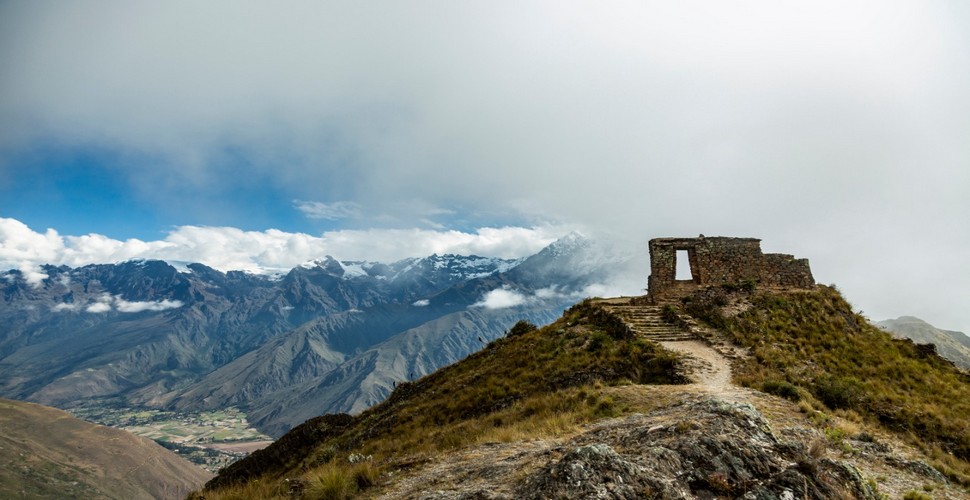
Remember to plan ahead. Book your alternative hike with a reputable tour operator like Valencia Travel. For your Peru adventure trip of a lifetime. Also, consider the level of difficulty and duration. As well as your personal interests, when choosing an alternative trek to Machu Picchu.
Whichever route you choose, you'll still experience natural beauty and archaeological wonders. Hidden in the Peruvian Andes. while ultimately reaching the awe-inspiring Machu Picchu. As you can see, there are many alternatives for your alternative Inca trail and Machu Picchu tour.
Valencia Travel Excels at Securing Inca Trail Permits!
Valencia Travel has an excellent track record in securing Inca Trail permits. For Machu Picchu trekking trips. We keep our trekkers informed of the procedures to secure permits. As well as how things work with the issuing organization.
This ensures that our trekkers reserve as soon as possible. They can secure their preferred dates. Often, our travelers reserve before the permits even go on sale! In this way, we can secure the perfect dates for our trekkers!
For certain dates in High Season, it is necessary to book even a year in advance!
FAQs About The Inca Trail to Machu Picchu
+The Most Frequently Asked Questions About The Inca Trail Hike to Machu Picchu
How To Get to Cusco Peru?
Most people will arrive in Cusco by air from Lima International Airport. Please remember that the Cusco airport is for domestic travel only. (With the exception being a daily flight to La Paz in Bolivia). If you come directly from overseas via Lima, you should collect your bags in Lima. You will then need to re-check them for your flight to Cusco.
Four airline carriers fly between Lima and Cusco. That includes LATAM Airlines, Star Peru, and SKY Airlines. They all offer similar schedules and in-flight service. We usually recommend LATAM airlines. They have the most daily departures. They also tend to be the most helpful when unexpected flight cancellations occur.
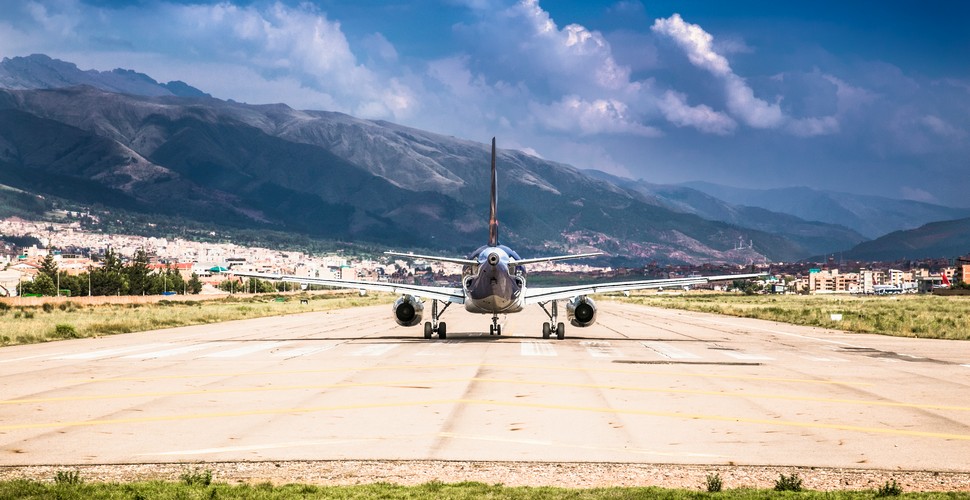
Huayna Picchu and Machu Picchu Mountain - Which One Should I Climb?
Machu Picchu Mountain takes around 3.5/ 4 hours (there and back) and the distance is around 5.68 km (3.5 miles). Huayna Picchu is 3 - 3.5 hours (return) and the distance is 4 km / 2.5 miles. The trail leading up Huayna Picchu is very narrow with sheer drops. Machu Picchu Mountain has a much wider trail without the scary drops.
Both mountains inside Machu Picchu offer you a spectacular panoramic view. Of the surrounding mountains and valleys. When you make it to the top of Huayna Picchu, you will be able to see the Machu Picchu ruins and Machu Picchu Mountain. Conversely, from the top of Machu Picchu Mountain, you can see the Machu Picchu ruins.
With Huayna Picchu as the backdrop. Therefore, you will find amazing spots to take your unforgettable photos. At the top of either mountain inside Machu Picchu! Make sure you purchase the correct circuit. To climb the mountain of your choice inside Machu Picchu. Find out more about Machu Picchu Circuits here.

Who Are The Porters?
Porters are those wonderful human beings who carry all the camping equipment. As well as the cooking equipment, and your personal equipment, along the Inca Trail. Pack animals are not allowed on the trail, such as horses, mules, or llamas. This is to protect the original trail from damage. The Inca Trail is regulated by the Peruvian government.
They implemented a permit system in the year 2000 to protect the pathway from erosion. This means that only human traffic is allowed to walk these ancient paths. The number of people who can be on the trail at any given time is also restricted to 500 per day. Including trekkers, porters, guides, and chefs.
Valencia Travel Cusco hires porters from the local communities. This is a way of providing employment to those in need. These communities are found all around the region. These are extremely remote with few work opportunities. See more information about Inca Trail permits here.

Maps, Altitudes, Weather, Distances and Practical Information about The Inca Trail Peru
+Practical Information About The Inca Trail Peru
The Inca Trail is one of the most awe-inspiring treks on the planet. Why is the Inca Trail in Peru so unique? Even those who have never hiked a multi-day trek include it on their Peru itineraries.
Why is it booked out almost a year in advance? Why is this trek considered to be one of the best treks in the world? There are very few treks that can compete with the Inca Trail. Especially when it comes to amazing Inca archaeological sites and spectacular and varied terrain.
The views will leave you in awe, and the destination, Machu Picchu, is a designated wonder of the world. It is the unusual combination of stunning nature with high Andean mountains. As well as the original Inca stone path.
There are giant steps that were used as an Andean highway centuries ago. All are standing peacefully in the cloud forest. It is tough to compare the sheer sense of wonder and achievement from hiking the Inca Trail.
Here is some practical information. Including distances and the best time of year to hike Machu Picchu. Altitude sickness, trekking elevations, and temperatures, etc. To make your experience the adventure of a lifetime.

Weather on The Trek
The weather when you trek to Machu Picchu generally depends on the season. April to September is the dry season. November to February is the rainy season. March and October are considered the shoulder seasons.
This means the climate can be unpredictable. Peru is in the southern hemisphere, so when it's summer in the USA and Europe, it is winter in Peru. June to August are the peak winter months in Peru, and November to February is summer. However, the rainy season in the Andes falls during the summer months.
So although there are warmer temperatures, the weather is wet. The weather patterns have become more variable in the past few years. So we recommend that you prepare for sun and rain all year round.

Elevation Gain - Ascents and Descents Along The Inca Trail
The total elevation climbed and descended on this trek is almost 1800M/ 6000ft. The Classic Inca Trail covers about 28 miles or 45 kilometers of hiking. The Inca Trail varies in altitude. From the lowest point at Machu Picchu, (2400 M/7872 ft.). To the highest part of the road at 4200 M/13,700 ft. This is called Warmiwañuska, better known as Dead Woman’s Pass.

Sustainability and Responsible Tourism along The Inca Trail Peru
+How To Be A Responsible Traveler Along The Inca Trail
Traveling to a culturally rich country like Peru, is an incredible experience. One that can leave a lasting impact on both the traveler and the destination. Tourism continues to grow in Peru. Especially in the Machu Picchu region.
Trekkers should be mindful that their presence contributes positively to the local communities. As well as the environment and culture. Here, we will aim to provide valuable insights and guidelines on how to be a responsible trekker. As you hike Machu Picchu, protect Peru's enchanting landscapes and unique cultural heritage.
How to Respect Peruvian Culture and Traditions:
Peru boasts a remarkable cultural heritage. It includes ancient civilizations like the Inca. As well as the customs and traditions of its indigenous communities. As a responsible tourist, it's crucial to respect and appreciate the local culture. This includes dressing modestly when visiting sacred sites.
Ask for permission before taking photos of people. Refraining from disrupting religious ceremonies. Remember that Machu Picchu and the Inca Trail are both culturally important to the Peruvian people. We need to follow the guidelines in place for the protection of the pathway.
These have been put in place by the Peruvian government. to protect these impressive national monuments.

Support the Local Economy
The most effective way to have a positive impact on a destination is by supporting its local economy. Prioritize staying in locally-owned accommodations. Dining at local restaurants. Purchase handmade crafts and products from local artisans and local businesses.
This practice ensures that your money directly benefits the communities you visit. creating a sustainable source of income for them. You will probably also get a lower price too! Make sure you book a locally run hotel before and after your Inca Trail. This will directly contribute to the local economy.

Choose Sustainable Tour Operators
Planning to hike the Inca Trail? Opt for tour operators such as Valencia Travel. We prioritize sustainability and responsible tourism practices. Look for those that follow ethical guidelines. Focus on minimizing their environmental footprint.
Those who treat their porters fairly and support local initiatives. Responsible tour operators often provide educational experiences too. That fosters an understanding of the local culture and environment.
Our Amazing Porters
Porters Rights
Are you planning to trek along the Inca Trail? Select a tour operator such as Valencia Travel. One that values and respects the rights of porters. Porters are the wonderful human beings who carry all the equipment.
This is necessary for the logistics of the hike. Ethical tour companies ensure that their porters are treated fairly. They pay decent wages, provide proper equipment, and work in safe conditions. They limit the weight porters carry and prioritize porter welfare throughout the journey. The general rule of thumb is the following.
The cheaper you pay for your Inca Trail Peru, the more it will directly affect the humble porters. You can be sure that corners are being cut. So, aim to pay a fair price for your Inca Trail adventure, rather than a low-cost Inca Trail Hike.

Minimize Plastic Waste on The Inca Trail
The issue of plastic pollution affects many destinations worldwide. The Inca Trail is no exception. Bring a reusable water bottle and a cloth bag to avoid single-use plastic items. Many hotels and restaurants in Peru are adopting eco-friendly practices.
So support their efforts by using eco-friendly products and avoiding unnecessary plastic consumption. On our Inca Trail Hikes, we minimize the use of plastics wherever possible.

Conserve Natural Resources
Peru is home to numerous diverse ecosystems. From the Amazon rainforest to the Andes Mountains. Be conscious of your water and energy usage. Especially in regions where resources might be scarce.
Opt for eco-friendly activities such as hiking the Inca Trail. Wildlife spotting and bird watching also have minimal impact on the environment.

Wildlife and Nature Interaction
Peru is renowned for its unique wildlife. This includes the majestic Andean condors and colorful Amazonian creatures. Along the trail, you will have many wildlife and nature interactions. You have the chance of spotting many birds.
These are unique to the cloud forest regions of the trek. This is also home to the Great Spectacled bear, which is classed as an endangered species. However, it's vital to maintain a respectful distance from these animals.
As well as their habitats. Avoid touching, feeding, or attempting to get too close to wild animals. This can disrupt their natural behavior. It can also affect the delicate ecosystems that surround the Inca Trail. Not to mention, Machu Picchu.
Dispose of Waste Responsibly Along The Inca Trail
A super important thing on your adventure is to always dispose of your waste responsibly. Use designated trash bins and recycling facilities. If none are available, carry your trash with you until you find an appropriate place to dispose of it.
The Inca Trail is surrounded by delicate natural habitats. This is where unique and endangered animals and plant life thrive. This is due to the lush cloud forest climate. It is therefore vital to protect the region.
For the wildlife, plant species, future generations of Peruvians, and other trekkers. We can make sure we cause no negative impact on the local environment. Remember to "leave only footprints."
Being a responsible traveler along the hike is about making conscious choices. These preserve the cultural heritage. They also protect their environment and natural habitats. As well as support its local communities.
By respecting local traditions. Supporting the local economy and choosing sustainable practices. In this way, you can leave a positive impact on this iconic trek. You can create unforgettable memories for yourself as you act responsibly.
It will inspire others to follow suit. This ensures that the Inca Trail remains a vibrant and cherished destination. For many generations to come.

Sustainable Practices for the Eco-Friendly Tourist in Peru
Peru has long been a magnet for travelers. Those seeking an adventure that combines natural wonders and historical intrigue. With the awe-inspiring ruins of Machu Picchu. The lush biodiversity of the Amazon rainforest.
The allure of Peru is undeniable. The global movement towards eco-consciousness is gaining momentum. So it becomes imperative for travelers to explore this remarkable country. With a commitment to sustainability. From supporting Indigenous artisans to responsible wildlife viewing in the Amazon.
Reducing plastic waste to respecting the rules along the Inca Trail. This guide is your roadmap to responsible and sustainable travel in Peru. Discover how you can immerse yourself in Peru's wonders. Leave only footprints and take away unforgettable memories and a sense of fulfillment.
Join us on this journey to explore the best of Peru. In a way that respects its heritage and protects its natural beauty. So that Machu Picchu via The Inca Trail remains in a decent state. For future trekkers, Peruvians, and the local flora and fauna.

Support Local Communities Near Machu Picchu
Stay in locally-owned accommodations. Eat in local restaurants, and buy handicrafts from local artisans. This helps the local economy! It also reduces the carbon footprint associated with large, international chains.
Responsible Wildlife Viewing
Visiting the Amazon rainforest? Hiking the Inca Trail, or other natural areas? Choose operators that follow ethical wildlife viewing guidelines. Avoid tours that engage in activities harmful to animals. These include riding them or getting too close to nesting sites.
Respect Cultural Heritage
Peru has a rich cultural history. Visiting archaeological sites like Machu Picchu? Or historic towns like Cusco? Be respectful of the heritage. Do not touch or climb on ancient structures along the trail. Follow the guidance of local authorities.
Reduce Plastic Use
Carry a reusable water bottle along the hike. Use water purification methods to reduce the need for single-use plastic bottles. Avoid using plastic bags and opt for reusable bags.

Minimize Energy and Water Consumption
Conserve resources by turning off lights, air conditioning, and heating. When not in use. Limit your water usage and choose accommodations with water-saving initiatives.
Choose Sustainable Tour Operators
Look for tour operators like Valencia Travel. Those who employ sustainability initiatives. Including waste reduction, renewable energy use, and low-impact transportation options. They should also employ local guides along the Inca Trail.
They will provide insight into the culture and ecosystem.

Responsible Trekking on The Trek
Planning to hike along the Inca Trail Trek? Use the services of operators who follow Leave No Trace principles. Pack out your waste, and choose responsible tour companies with responsible camping practices.
Public Transportation
Use public transportation or shared transportation options. Especially when moving between cities or exploring regions. This helps reduce the carbon footprint associated with private vehicles.
Opt for Eco-Lodges Where You Can on Your Machu Picchu Trip
Choose accommodations that are certified as eco-friendly or sustainably operated. These lodges often have initiatives in place to minimize their environmental impact.
Learn About the Local Ecosystem
Take the opportunity to educate yourself about the local flora and fauna of Machu Picchu. Understanding the environment on the Inca pathway helps you appreciate it more. It also encourages its protection.

Reduce Water Waste
Be mindful of water consumption, especially in regions where water is scarce. Take shorter showers and reuse towels to reduce the need for frequent washing.
Dispose of Waste Properly
Always use designated trash and recycling bins. Do not litter along the pathways. In rural areas, pack out your trash to avoid impacting local ecosystems.
Discover how you can immerse yourself in Peru's wonders, such as the Inca Trail. Leave only footprints and take away unforgettable memories and a sense of fulfillment. Join us on this journey along the iconic Inca pathway.
To explore the best of Peru in a way that respects its heritage and protects its natural beauty.

The Importance of Environmental Awareness On The Inca Trail
Peru is a land of astonishing ecological diversity. With rugged mountain ranges and ancient civilizations. This stands as a testament to the remarkable harmony between nature and culture. From the Amazon rainforest to the magnificent Inca Trail in the majestic Andes.
As well as the mysterious Nazca Lines etched in the arid desert. Peru's landscapes hold an exceptional beauty that has captured the world's imagination. Beneath this enchanting facade lies a delicate balance.
This requires our vigilant care and environmental consciousness. Environmental awareness is of vital importance. Read on for more useful information!

Biodiversity and Conservation
Peru is one of the world's most biologically diverse countries. Home to a wide range of ecosystems. These include the Amazon rainforest, the Andes mountains, and the coastal deserts. Preserving this biodiversity is crucial for the health of the planet as a whole. As well as for future generations.
Strict rules are in place along the Inca Trail and at Machu Picchu. As a company, we respect these 100%. We ask our clients to also comply with these rules. (Your guide will tell you what they are :) Throughout their expedition.
Indigenous Communities Around Machu Picchu
Many indigenous communities in Peru rely on the environment. For their livelihoods and cultural identity. Environmental awareness is essential to protect their rights. This ensures that their traditional knowledge is respected. In the Andean region, you will see a number of traditional farming communities.
This is where the Inca Trail is located. The people use the same farming practices as they have done, for generations. Especially in the Sacred Valley and the lands around the Inca Trail and Machu Picchu. Where the land is incredibly fertile. Local farmers depend on this for their livelihood.
Climate Change In The Machu Picchu Region and Cusco
Peru is particularly vulnerable to the impacts of climate change. Including glacial melting in the Andes and extreme weather events. Raising awareness about climate change is essential. To mitigate these effects and adapt to new challenges.
Remember, the famous Rainbow Mountain has only recently been discovered! This is due to the snow caps melting at this high elevation of the Ausangate Mountain Range. Previously, it was covered in snow.
The Inca Trail can also be affected by global warming. With higher rivers due to the surrounding icecaps melting.

Peru is a major producer of agricultural products, including quinoa and coffee. Environmental awareness in Peru is critical for promoting sustainable farming practices. These preserve soil and water resources.
While the Inca Trail is considered a national monument so there is no farming as such. Other trekking routes, such as the Salkantay Trek. Pass through coffee and cocoa plantations.
Trekkers can visit these plantations sustainably. Maybe even purchase some delicious coffee! This means that you are directly contributing to the local coffee producers.
Ecotourism Along The Inca Trail
Peru's natural beauty includes the Amazon River, Machu Picchu, and the Inca Trail. This is a major driver of its economy through tourism. Environmental conservation is essential for preserving these attractions and maintaining the tourism industry. For this, visits to these iconic sites have to be sustainable.
There are rules in place when you hike Machu Picchu for its preservation. As well as the surrounding ecosystems.

Water Resources Near The Inca Trail
Access to clean water is a fundamental human right. Many Peruvians rely on rivers and lakes for their water supply. Protect these water sources from pollution close to the trail. It is vital not only for trekkers on their Inca Trail but also for the local communities.
This is why it is important to practice sustainable trekking practices. These include adequate disposal of garbage and the "packing in, packing out" philosophy.

Illegal Logging and Mining in Peru
Peru faces challenges from illegal logging and mining activities. These can have devastating effects on the environment. This is especially so in the Amazon rainforest, just below the cloud forests of Machu Picchu! Cusco also has a lot of mining activity, which is detrimental to the local environment.
Environmental awareness can help combat these illegal activities. Promoting sustainable natural resource management.

International Commitments
Peru is a signatory to international agreements and conventions. These are aimed at environmental protection. Such as the Paris Agreement and the Convention on Biological Diversity. Environmental awareness is crucial for fulfilling these commitments.
Public Health Near Machu Picchu
Environmental degradation can have a direct impact on public health. Especially in terms of air and water pollution. Promoting environmental awareness can help reduce these health risks. Luckily, there are no roads to Machu Picchu, only the Inca Trail, and the train will take you there. This is strictly monitored to protect the local environment.

Long-term Economic Viability
Sustainable environmental practices are essential for the long-term economic well-being of Peru. Environmental degradation can lead to increased costs. As well as reduced agricultural productivity, and the loss of natural resources.
If visits to Machu Picchu and the people who hike the Inca Trail are not adequately controlled. This could negatively impact the local environment.
Environmental awareness in Peru is crucial for preserving the country's unique natural resources. As well as protecting the rights and livelihoods of Peru´s indigenous communities. Ensuring a sustainable and healthy future for its citizens.
It also plays a significant role in Peru's global commitment to environmental protection. As well as its economic stability. The importance of environmental awareness in Peru cannot be overstated. This nation is a treasure trove of biodiversity. This is a testament to the enduring traditions of its indigenous communities.
It is a country where the effects of climate change are acutely felt. Sustainable agriculture and responsible tourism are pivotal to the economy. Where the protection of vital water resources is non-negotiable. Machu Picchu is a Wonder of the World, and the Inca Trail is a bucket list item for many.
This automatically means that both will receive a lot of visitors. However, this needs to be controlled. The hike is restricted to 500 people per day. Including support staff along the trail. This is so that damage is not caused by over-trekking the ancient route.
See more about Inca Trail Permits and booking in advance here. Peru's environmental challenges and triumphs resonate globally. As it navigates the intricate interplay of conservation, culture, and development.

How is Valencia Travel Cusco a Sustainable Travel Company?
We have spent years investing in the remote Andean communities we hike through. From "chocolatadas" and training courses for local people. To supporting women’s rights in Andean communities. As well as our commitment to porter welfare.
We treat our staff right! Whether in the Cusco office or out on the Inca Trail. We combine fair (above-market) wages. Provide benefits and flexible working conditions for staff with families. We also pay our taxes (You would be surprised how many companies don´t!).

Being a Responsible Travel Company is Vital.
For Valencia Travel, Responsible Tourism means protecting the environment. Making ethical choices. Respecting and facilitating local culture, and being good members of this global community. We are serious when it comes to promoting responsible travel in Peru. Especially along The Inca Trail Hike.

So, what exactly are we doing at Valencia Travel?
We Treat Our Staff Well
Being a responsible tour operator starts at home. That means that our operations center around the well-being of our staff team. Including the office staff, porters, guides, cooks, and muleteers. See more in our About Us section.

We Facilitate Opportunities for Local Communities
We have been committed to providing work to those whose communities we trek through. This includes those on our Inca Trail hikes.
We Regularly Give Back to the Community
Since the beginning, we have always believed that we need to do more. Not just responsibly operate treks. We offer free community training. We provide donations and chocolatadas to remote communities.
We visit local rural communities on most of our multi-day tours. To provide a sustainable income to the community members.

Ongoing Dedication to Sustainability in Tourism
We recently collaborated on a tree-planting activity in the Rukha Community. (see our video). We continue to improve, to keep on top of our sustainability initiatives.
We are proud that we’ve been able to keep our treks at a reasonable price. Even while continually taking our commitment to sustainability and responsible treks extremely seriously. Ensuring that our Inca Trail adventures remain accessible to the eco-friendly traveler.

The New Porter's Law
For anyone who has ever trekked in the Cusco region. Or hiked the world-famous Inca Trail. You will have realized that the porters are a fundamental part of any trekking team. Without the hard-working porters and their smiling faces each day.
This trekking experience would not be nearly as incredible for our clients. Their underrated importance led to the government deciding to protect their rights. They decreed a new law for trekking companies. The exploitation of the porters of the iconic hike is nothing new. For decades, many people have echoed the porters’ struggle.
To be entitled to better working conditions. The new law 31614, or "Porter’s law", was approved by the Peruvian Congress. Signed by the Peruvian president, Pedro Castillo. Appears to address some of the many issues these wonderful people face.
The History of The Concern For Porters
For those who haven’t heard about the mistreatment of porters. An overwhelming majority of these hard-working men and women. Have complained about carrying excessive weight on their backs. Way beyond the 20 kg limit. They receive poor salaries, lack food, and proper sleeping conditions.
They also have inadequate equipment. This is to haul the necessary supplies for tourists. So they can accomplish this world-famous trek. Despite the good intentions behind the conception of this new law. Many questions have arisen regarding the implementation of such a law. As well as its actual effect on porters, tourists, and tour operators alike.

What Is the New Law, And How Is It Different from the Previous Law?
On a fundamental level, some aspects of the previous law have remained. Such as the weight limits that porters carry, which are 20kg (45 lbs) for men and 15kg (34 lbs) for women. Also, tour operators are obliged to provide porters with adequate food.
As well as appropriate camping gear. Suitable clothing for the trekking activity, including hiking boots, sleeping pads, and tents.
Most of the porters on the Inca Trail are people from the high Andean areas. In general, they speak Quechua and Spanish.
They are people who work in the field, but when the high season arrives, they do this work to increase their income. Some others dedicate themselves completely to this work.

On other alternative treks in the region, pack animals are usually used. This is to carry all the equipment. However, on the Inca Trail, the use of mules is prohibited. This is why humans have to carry all the essential camping items. As well as the clients' belongings. Porters are also responsible for setting up the campsite.
This has to be ready when the trekkers arrive. Regardless of what time they leave the checkpoint. This is harder for those carrying more weight, of course. The new law for the porters stipulates exactly the maximum weight they can carry.

Obviously, the porters know the route perfectly. They have a very good physical condition. They can even make the walk at a brisk pace and without major inconvenience. In some cases, (depending on the company), they even do running sections to be able to get ahead and do their job on time.
What´s New
The new law requires that the new salary for an entire four-day trip is 140 USD. This is more than double what they earned in 2022. Also, Tour operators must provide porters with a health insurance plan. As well as deliver an accident insurance policy.
The Peruvian government also agrees to build shelters for porters to sleep on the trek. They will implement an area of “rapid assistance” in the event of accidents. With permanent health personnel on hand at all times. Furthermore, porters must have 5 days' rest before they start another trek. 30% of the resources were collected by the Ministry of Culture and SERNANP. Will be assigned to the Regional Federation of Inca Trail Porters.
To promote and encourage tourist activity, as well as to create a solidarity fund for porters. This will improve their working and social conditions. Previously, porters often slept outside, in the bathrooms. Or in the dining tents. Without adequate sleeping arrangements. This is especially harsh due to the high elevations along the trail.
Current Issues
The new law does not consider the inclusion of women. Nor does it establish a mandatory quota of women. This is to increase their participation in this industry. The number of women porters has been on the increase. So, equal opportunities have been a real issue.
Also, there should be a clear path for enforcing this law to keep the ruling body accountable. SUNAFIL is a well-known government institution. They have a somewhat dubious reputation regarding the enforcement of fair labor practices.
The current law protecting porters has been in place since 2003. Despite the differences between the new and old laws. The problem has always been how to enforce them properly.
Some unscrupulous tour operators had no concerns about their porters. They were just operating the trek for financial reasons. They were found to be offering bribes to park rangers.
This led to the important question of how to operate a sustainable model on the Inca Trail. Managing the law for the benefit of the porters.
Moreover, the Porter’s Federation doesn’t have a say in how operators are held accountable. which substantially limits their ability to find meaningful change. Under these circumstances, what happened before will likely happen again. As no clear path to enforce the new law has been established.

Some dishonest tour operators made sure porters went across the first checkpoint. Only carrying the maximum weight allowed. However, using several tricks to ‘avoid being caught,’. They forced the porters to carry extra weight as soon as they reached the first campsite.
This problem is not exclusive to tour agencies. Corruption runs rampant in almost every Peruvian public institution. According to a survey conducted in 2022, 80% of people believe corruption is the main problem in Peru.
The numbers don’t lie; corruption has plagued even the highest spheres of power in Peru. Three out of four ex-Peruvian presidents are in jail. Expecting extradition or facing criminal charges for corruption. One other person committed suicide before getting arrested for the same reasons.
In June 2022, a group of Peru’s Ministry of Culture employees. (locally known as GERCETUR). This included the Machu Picchu Park director. They were sacked after protests demanding their resignation, which took place in Machu Picchu. As always, corruption was at the center of it. Authorities discovered that people were buying Machu Picchu tickets. To then resell at higher prices. All with the collaboration of workers inside this Peruvian institution.

The Real Problem
Honest tour operators have always experienced a conflict. Between the service they provide to tourists and the number of porters available. It has always been a complex issue to deal with. The park laws regulate the amount of weight and porters allowed on the Inca Trail. This limits the array of things provided for the tourists.
Since 2003, tour operators have substantially improved their clients’ services to stay competitive. For instance, they provide them with unnecessary excessive goodies. Such as portable bathrooms, showers, and cooking classes.
As well as free porters to carry their personal belongings. All of it has only exacerbated the working conditions of the porters. They have to transport these things. While being deprived of the essential items to work decently. Such as food, shelter, and proper bags to carry belongings.
Will the New Law Work?
Hopefully, yes! Although most porters believe that their ability to work freely is threatened. Especially by a clause in the law mandating that they rest for five days after every trip.
The new law does not create the conditions for more women to be included in this industry. As it is much cheaper to hire men only to do this job. Women porters carry 5kg less than men, so to carry 60kg, tour operators prefer to hire 3 men instead of 4 women. Hiring women involves higher costs. Higher salaries, food, entrance fees, insurance, and other expenses.
The new law may work effectively for the first few months. But once the dust settles, things are likely to go back to the same corrupt ways as before. In fact, it might even get worse for porters due to the levels of corruption in Peru.

How Will This Affect Trekkers?
The bottom line is that the new law will increase the operational costs of the Inca Trail. By 200% to 300% compared to those of 2022. Also, the prices of tours will increase by up to 50% or 100% more than the 2022 prices.
It is improbable that operators will deliver tours without raising prices. Some tour operators are already in conversations with clients. To voluntarily agree to pay the extra costs for trips they have already signed up for. Implementing this law will mean that some trekkers will probably look for cheaper alternatives. while others might withdraw their requests to hike on the Inca Trail.
The problem with looking for cheaper alternatives is that it perpetuates the issue. Porters have fought for so long to get a new law. The only way to offer cheaper alternatives is to force the porters to carry excess weight.

The Chance for a Sustainable and Ethical Trek, and The Role Of Trekkers
Now, more than ever, hiking on the Inca Trail provides the chance for hikers to play a positive role. Especially concerning sustainable travel. First, by choosing an ethical tour operator like Valencia Travel. Secondly, by holding tour operators accountable for their labor practices. Trekkers will pay more for these tours. This gives them an excellent opportunity to demand that porters receive decent treatment. As well as that, the tour operators treat porters with dignity and respect.
Our View At Valencia Travel Cusco
Leaving aside any inconsistencies with the new Porter's law. Our values will always be aimed at being a responsible, sustainable tourism agency. We look after not only the well-being of tourists but also each one of the people who are part of our team. Any positive action, by law. Or an initiative to empower the porters. Coming from the Peruvian government or any private organization. It should be welcomed and supported by all involved in the travel industry. This will only happen when laws consider the opinion of the porters’ leadership. When they are given the power to enforce these laws. Without that, they are deprived of all means to safeguard their interests. Especially when they have to confront the unethical, powerful tour operators, as well as corrupt government officials.

For Valencia Travel Cusco, the porters are an integral and vital part of our team. Without them, we would not be able to operate The Inca Trail to the high standard we offer our clients. This new law may be good for the porters, but only time will tell. In the meantime, it’s up to trekkers to book with ethical and responsible tour operators. To keep an eye on how porters are treated to ensure we don’t lose the hard-earned momentum we’ve gained. Valencia Travel will continue to offer the best services to our porters. Complying with the law at all times. To be the ethical and responsible operators for which we are known. Without affecting the excellent service that our trekkers receive. Find out more here.
Book Your Inca Trail Package
 card-tag-title16% off
card-tag-title16% offClassic Inca Trail
4daysThe Inca Trail trek to Machu Picchu is the ultimate bucket list hiking experience! Join us on this Classic 4 Day & 3 night Inca Trail Hike!
 card-tag-title10% off
card-tag-title10% offTrek Along the Inca Trail To Machu Picchu
7daysTrek Along The Inca Trail To Machu Picchu with Valencia Travel. We are a renowned Peruvian tour company offering trekking experiences throughout Peru.
 card-tag-title15% off
card-tag-title15% offInca Trail Express to Machu Picchu
5daysOn this Express Inca Trail, you will witness fantastic views, spectacular ancient ruins, and the sunset over Machu Picchu! Join us on this iconic Inca Trail trek!
 card-tag-title13% off
card-tag-title13% offShort Inca Trail to Machu Picchu
2daysTrek the short Inca Trail in just two days without missing out on any beautiful sights with our Inca Trail 2 days!
 card-tag-title
card-tag-titleClassic Inca Trail Trek to Machu Picchu
5daysThis 5 Day classic Inca Trail trek is an unforgettable experience. Combining history, wildlife, and spectacular scenery at a more relaxed pace!
 card-tag-title
card-tag-titleClassic Inca Trail - Premium
4daysThis private Inca trail to Machu Picchu allows a taste of the Inca trail with some additional creature comforts! Sign up for this trek with Valencia Travel!
contant-us-title

specialist-box-title
Maria Diaz
specialist-box-phrase
RELATED TOURS
top-tours-info

Salkantay Trek to Machu Picchu
5daysThe spectacular Salkantay Trek to Machu Picchu is one of the best treks in the Andes! Join us on this stunning Andean trekking adventure!
card-activity-tagModerate - Demanding

Lares Trek & Machu Picchu
7daysAllow Valencia Travel to take you on the Lares Trek & Machu Picchu. This cultural Lares trekking trip will take you deep into the Andes of Peru!
card-activity-tagModerate

Choquequirao Trek to Machu Picchu
9daysValencia Travel invites you on the spectacular Choquequirao Trek to Machu Picchu. Traverse mountain passes and explore ancient Inca sites on an expedition to Machu Picchu!
card-activity-tagModerate - Demanding
asso-info-title
asso-info-description
 Aventure
Aventure
 Cultural
Cultural
 Gastronomy
Gastronomy
 Wellness
Wellness
 Local Living
Local Living
 Luxury
Luxury



















